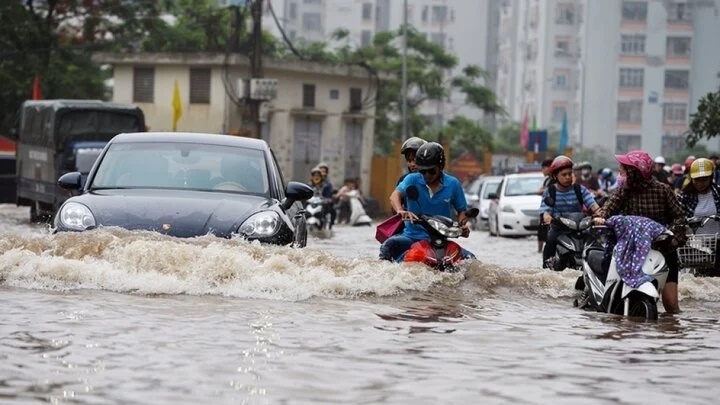The reasons why a car stalls when it is flooded
When a car enters a flooded area and the water surpasses the exhaust pipe, if the throttle is at a very low speed or not pressed, the air will be expelled slowly, causing the water to enter the exhaust pipe and block the escape route, leading to the possibility of the car stalling.
When the water level is higher than the air intake, the water will overflow into the air intake, along with the air entering the combustion chamber. The mixture of fuel, air, and water will not ignite, resulting in the car stalling.

Many people experience their cars stalling when entering a flooded area. (Illustration: hautruongauto.com)
A simple way to prevent a car from stalling when it is flooded
For cars
According to experts in safe driving, when encountering flooded roads, it is recommended to drive at a low gear and turn off all auxiliary loads such as air conditioning, entertainment systems, etc. to increase the engine’s operating capability.
For automatic cars, the driver should press the throttle slowly and avoid sudden acceleration. This is because when driving in crowded, flooded areas, sudden acceleration and braking can cause water to enter the air intake, causing hydrostatic lock. Therefore, the driver should pause, observe if the flooded distance is wide enough to pass.
It is especially important not to stop in the flooded area. If it is necessary to stop, shift to neutral, engage the parking brake, and keep the throttle. When it is possible to continue moving, quickly shift to gear and pass through the flooded area.
Drive at a high RPM and low gear – depending on the type of transmission. Maintain a steady speed. Do not remove your foot from the accelerator pedal. The engine, when decelerating, can suck water in through the exhaust pipe and damage the catalytic converter. Surely, you do not want the front air filter to suck in water into the engine, so drive very slowly. In both cases, the damage will be severe and the repair cost will be high.
In deep flooded areas, the best solution is to stop the car completely. In case water enters the engine compartment and the interior, causing the engine to stall, the driver should call for assistance to take the car to a repair station for the best solution and minimize economic loss.
For motorcycles
For manual motorbikes, the driver should shift to a low gear, such as gear 1 or 2, when passing through flooded areas. Pay attention to maintaining a steady throttle, hold the handlebars tightly, and drive slowly through the submerged area. Avoid sudden acceleration or braking, as it can make the engine stall more easily.
For scooters, control the throttle slowly and steadily, neither too high nor too low. Absolutely do not reduce the throttle during the entire process, as this will immediately cause the engine to stall. If encountering places where the water is deep enough to reach the muffler, it is best not to drive through those areas.
If the motorcycle is heavily flooded and stalls, there is a temporary solution of pushing the bike to a higher place, then remove the spark plug and dry it thoroughly. After that, kickstart to expel water from the bike, lock the fuel, and drain all the fuel from the carburetor.
According to VTC news

































